cooling Peugeot 207 Dag 2007.5 Owner's Manual
[x] Cancel search | Manufacturer: PEUGEOT, Model Year: 2007.5, Model line: 207 Dag, Model: Peugeot 207 Dag 2007.5Pages: 223, PDF Size: 9.01 MB
Page 14 of 223
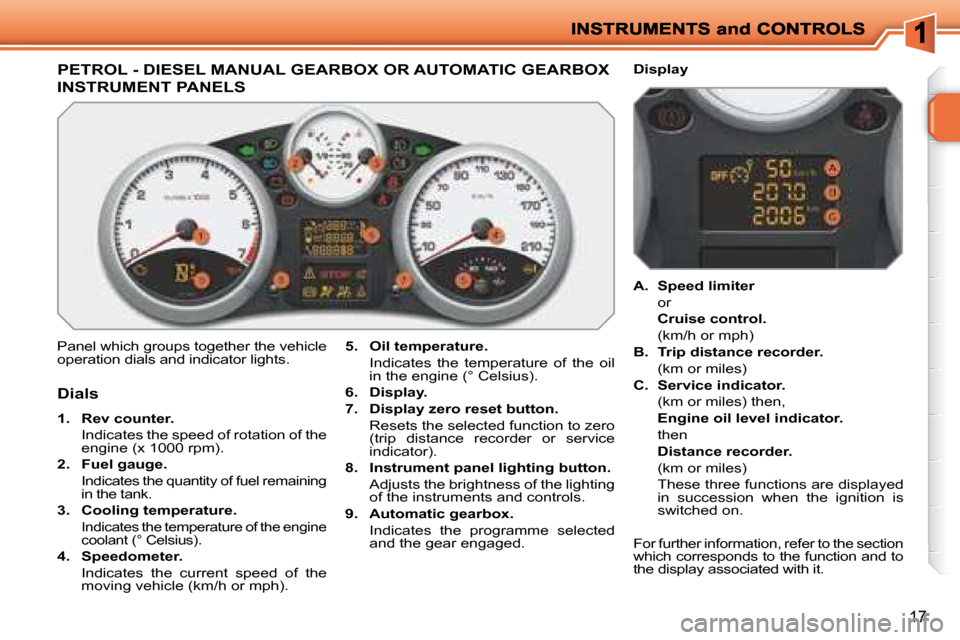
17
PETROL - DIESEL MANUAL GEARBOX OR AUTOMATIC GEARBOX
INSTRUMENT PANELS
Panel which groups together the vehicle
operation dials and indicator lights.
5. Oil temperature.
Indicates the temperature of the oil in the engine (° Celsius).
6. Display.
7. Display zero reset button.
Resets the selected function to zero (trip distance recorder or service
indicator).
8. Instrument panel lighting button.
Adjusts the brightness of the lighting of the instruments and controls.
9. Automatic gearbox.
Indicates the programme selected and the gear engaged.
Dials
1. Rev counter.
Indicates the speed of rotation of the engine (x 1000 rpm).
2. Fuel gauge.
Indicates the quantity of fuel remaining
in the tank.
3. Cooling temperature.
Indicates the temperature of the engine
coolant (° Celsius).
4. Speedometer.
Indicates the current speed of the moving vehicle (km/h or mph).
A. Speed limiter
or
Cruise control.
(km/h or mph)
B. Trip distance recorder.
(km or miles)
C. Service indicator.
(km or miles) then,
Engine oil level indicator.
then
Distance recorder.
(km or miles)
These three functions are displayed in succession when the ignition is
switched on.
For further information, refer to the section
which corresponds to the function and to
the display associated with it.
Display
Page 18 of 223
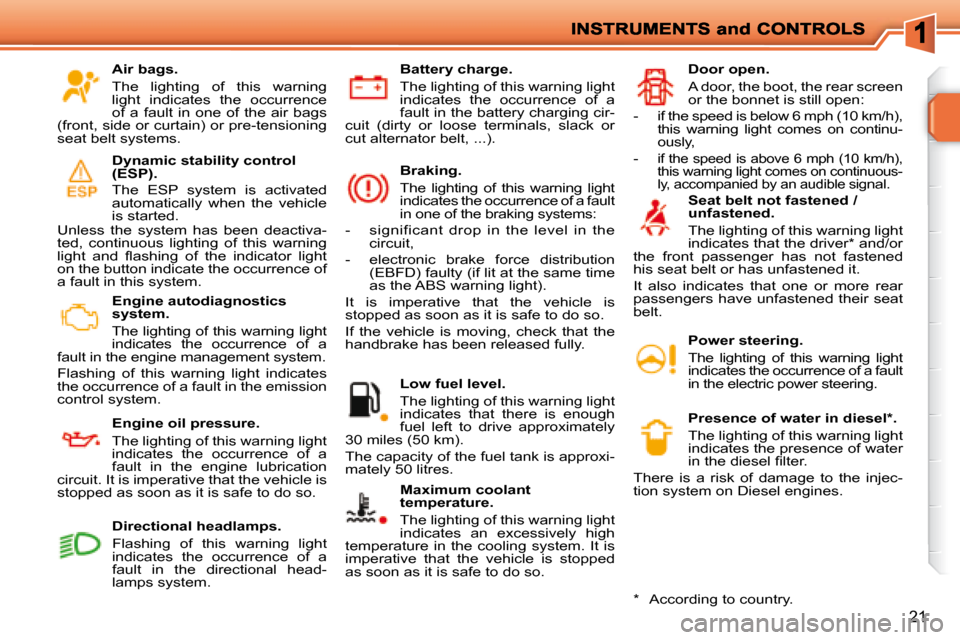
21
Air bags.
The lighting of this warning
light indicates the occurrence
of a fault in one of the air bags
(front, side or curtain) or pre-tensioning
seat belt systems.
Dynamic stability control
(ESP).
The ESP system is activated
automatically when the vehicle
is started.
Unless the system has been deactiva-
ted, continuous lighting of this warning
�l�i�g�h�t� �a�n�d� �l� �a�s�h�i�n�g� �o�f� �t�h�e� �i�n�d�i�c�a�t�o�r� �l�i�g�h�t�
on the button indicate the occurrence of
a fault in this system.
Engine autodiagnostics
system.
The lighting of this warning light
indicates the occurrence of a
fault in the engine management system.
Flashing of this warning light indicates
the occurrence of a fault in the emission
control system.
Engine oil pressure.
The lighting of this warning light
indicates the occurrence of a
fault in the engine lubrication
circuit. It is imperative that the vehicle is
stopped as soon as it is safe to do so. Battery charge.
The lighting of this warning light
indicates the occurrence of a
fault in the battery charging cir-
cuit (dirty or loose terminals, slack or
cut alternator belt, ...).
Braking.
The lighting of this warning light
indicates the occurrence of a fault
in one of the braking systems:
- significant drop in the level in the circuit,
- electronic brake force distribution (EBFD) faulty (if lit at the same time
as the ABS warning light).
It is imperative that the vehicle is
stopped as soon as it is safe to do so.
If the vehicle is moving, check that the
handbrake has been released fully.
Low fuel level.
The lighting of this warning light
indicates that there is enough
fuel left to drive approximately
30 miles (50 km).
The capacity of the fuel tank is approxi-
mately 50 litres.
Maximum coolant
temperature.
The lighting of this warning light
indicates an excessively high
temperature in the cooling system. It is
imperative that the vehicle is stopped
as soon as it is safe to do so. Door open.
A door, the boot, the rear screen
or the bonnet is still open:
- if the speed is below 6 mph (10 km/h), this warning light comes on continu-
ously,
-
if the speed is above 6 mph (10 km/h),
this warning light comes on continuous-
ly, accompanied by an audible sig
nal.
Seat belt not fastened /
unfastened.
The lighting of this warning light
indicates that the driver * and/or
the front passenger has not fastened
his seat belt or has unfastened it.
It also indicates that one or more rear
passengers have unfastened their seat
belt.
Power steering.
The lighting of this warning light
indicates the occurrence of a fault
in the electric power steering.
Presence of water in diesel * .
The lighting of this warning light
indicates the presence of water
�i�n� �t�h�e� �d�i�e�s�e�l� �i� �l�t�e�r�.�
There is a risk of damage to the injec-
tion system on Diesel engines.
Directional headlamps.
Flashing of this warning light
indicates the occurrence of a
fault in the directional head-
lamps system.
* According to country.
Page 19 of 223
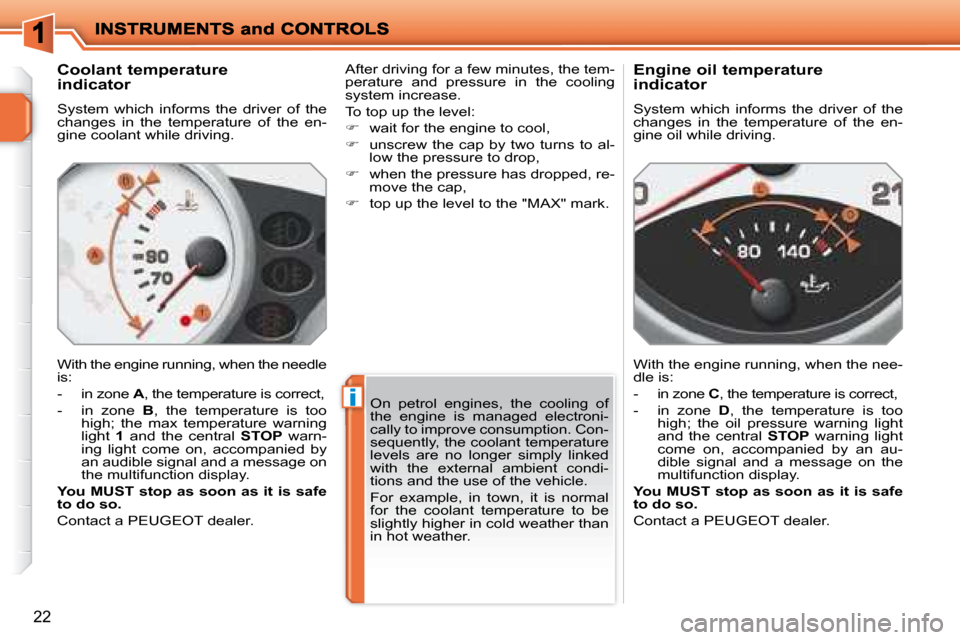
i
22
Coolant temperature
indicator
System which informs the driver of the
changes in the temperature of the en-
gine coolant while driving.
With the engine running, when the needle
is:
- in zone A , the temperature is correct,
- in zone B , the temperature is too
high; the max temperature warning
light 1 and the central STOP warn-
ing light come on, accompanied by
an audible signal and a message on
the multifunction display.
You MUST stop as soon as it is safe
to do so.
Contact a PEUGEOT dealer. After driving for a few minutes, the tem-
perature and pressure in the cooling
system increase.
To top up the level:
� wait for the engine to cool,
� unscrew the cap by two turns to al-
low the pressure to drop,
� when the pressure has dropped, re-
move the cap,
� top up the level to the "MAX" mark. Engine oil temperature
indicator
System which informs the driver of the
changes in the temperature of the en-
gine oil while driving.
With the engine running, when the nee-
dle is:
- in zone
C , the temperature is correct,
- in zone D , the temperature is too
high; the oil pressure warning light
and the central STOP warning light
come on, accompanied by an au-
dible signal and a message on the
multifunction display.
You MUST stop as soon as it is safe
to do so.
Contact a PEUGEOT dealer.
On petrol engines, the cooling of
the engine is managed electroni-
cally to improve consumption. Con-
sequently, the coolant temperature
levels are no longer simply linked
with the external ambient condi-
tions and the use of the vehicle.
For example, in town, it is normal
for the coolant temperature to be
slightly higher in cold weather than
in hot weather.
Page 39 of 223
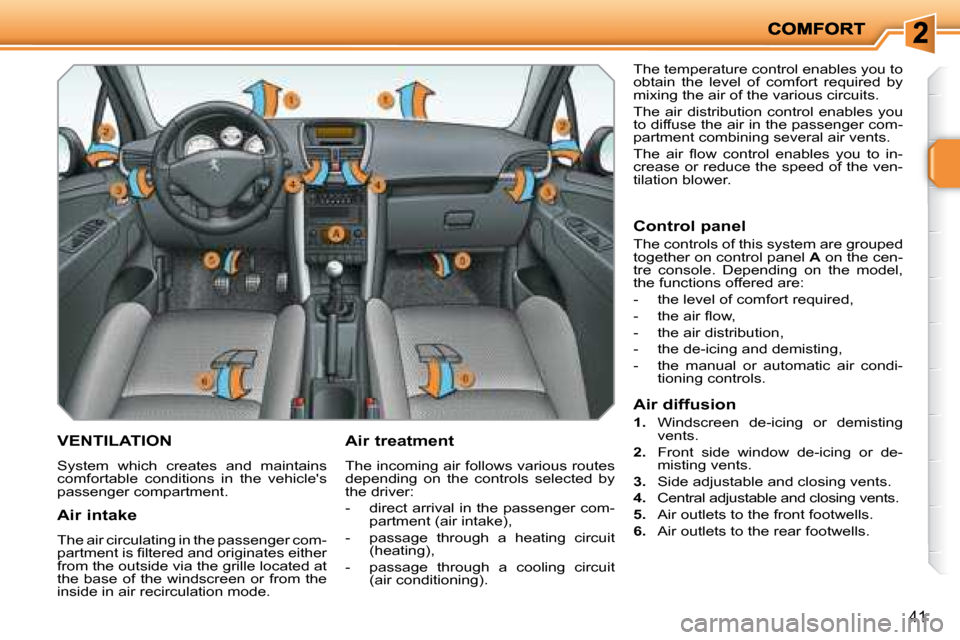
41
VENTILATION
System which creates and maintains
comfortable conditions in the vehicle's
passenger compartment. Air treatment
The incoming air follows various routes
depending on the controls selected by
the driver:
- direct arrival in the passenger com-
partment (air intake),
- passage through a heating circuit (heating),
- passage through a cooling circuit (air conditioning). The temperature control enables you to
obtain the level of comfort required by
mixing the air of the various circuits.
The air distribution control enables you
to diffuse the air in the passenger com-
partment combining several air vents.
� �T�h�e� �a�i�r� �l� �o�w� �c�o�n�t�r�o�l� �e�n�a�b�l�e�s� �y�o�u� �t�o� �i�n�-
crease or reduce the speed of the ven-
tilation blower.
Air intake
The air circulating in the passenger com-
�p�a�r�t�m�e�n�t� �i�s� �i� �l�t�e�r�e�d� �a�n�d� �o�r�i�g�i�n�a�t�e�s� �e�i�t�h�e�r�
from the outside via the grille located at
the base of the windscreen or from the
inside in air recirculation mode. Control panel
The controls of this system are grouped
together on control panel
A on the cen-
tre console. Depending on the model,
the functions offered are:
- the level of comfort required,
� � �-� � �t�h�e� �a�i�r� �l� �o�w�,�
- the air distribution,
- the de-icing and demisting,
- the manual or automatic air condi- tioning controls.
Air diffusion
1. Windscreen de-icing or demisting
vents.
2. Front side window de-icing or de-
misting vents.
3. Side adjustable and closing vents.
4. Central adjustable and closing vents.
5. Air outlets to the front footwells.
6. Air outlets to the rear footwells.
Page 48 of 223
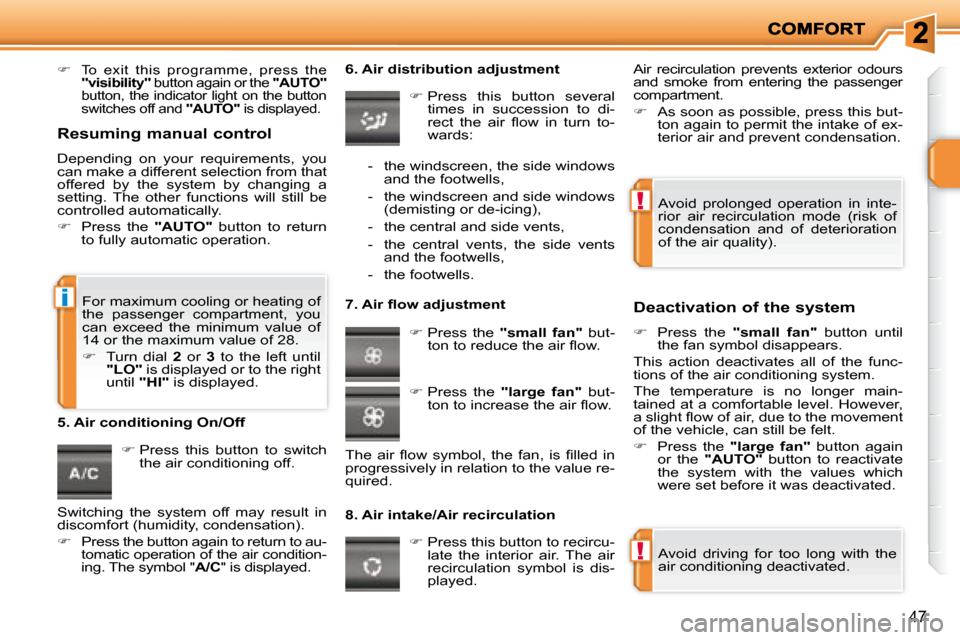
!
!
i
47
� To exit this programme, press the
"visibility" button again or the "AUTO"
button, the indicator light on the button
switches off and "AUTO" is displayed.
� Press this button to switch
the air conditioning off. � � �6�.� �A�i�r� �d�i�s�t�r�i�b�u�t�i�o�n� �a�d�j�u�s�t�m�e�n�t�
� Press this button several
times in succession to di-
�r�e�c�t� �t�h�e� �a�i�r� �l� �o�w� �i�n� �t�u�r�n� �t�o�-
wards:
� � �7�.� �A�i�r� �l� �o�w� �a�d�j�u�s�t�m�e�n�t�
� Press the "small fan" but-
�t�o�n� �t�o� �r�e�d�u�c�e� �t�h�e� �a�i�r� �l� �o�w�.�
8. Air intake/Air recirculation Deactivation of the system
� Press the "small fan" button until
the fan symbol disappears.
This action deactivates all of the func-
tions of the air conditioning system.
The temperature is no longer main-
tained at a comfortable level. However,
�a� �s�l�i�g�h�t� �l� �o�w� �o�f� �a�i�r�,� �d�u�e� �t�o� �t�h�e� �m�o�v�e�m�e�n�t�
of the vehicle, can still be felt.
� Press the "large fan" button again
or the "AUTO" button to reactivate
the system with the values which
were set before it was deactivated.
� Press this button to recircu-
late the interior air. The air
recirculation symbol is dis-
played.
5. Air conditioning On/Off
Avoid driving for too long with the
air conditioning deactivated.
Avoid prolonged operation in inte-
rior air recirculation mode (risk of
condensation and of deterioration
of the air quality).
- the windscreen, the side windows
and the footwells,
- the windscreen and side windows (demisting or de-icing),
- the central and side vents,
- the central vents, the side vents and the footwells,
- the footwells.
� Press the "large fan" but-
�t�o�n� �t�o� �i�n�c�r�e�a�s�e� �t�h�e� �a�i�r� �l� �o�w�.� �
� �T�h�e� �a�i�r� �l� �o�w� �s�y�m�b�o�l�,� �t�h�e� �f�a�n�,� �i�s� �i� �l�l�e�d� �i�n�
progressively in relation to the value re-
quired. Air recirculation prevents exterior odours
and smoke from entering the passenger
compartment.
� As soon as possible, press this but-
ton again to permit the intake of ex-
terior air and prevent condensation.
For maximum cooling or heating of
the passenger compartment, you
can exceed the minimum value of
14 or the maximum value of 28 .
� Turn dial 2 or 3 to the left until
"LO" is displayed or to the right
until "HI" is displayed.
Resuming manual control
Depending on your requirements, you
can make a different selection from that
offered by the system by changing a
setting. The other functions will still be
controlled automatically.
� Press the "AUTO" button to return
to fully automatic operation.
Switching the system off may result in
discomfort (humidity, condensation).
� Press the button again to return to au-
tomatic operation of the air condition-
�i�n�g�.� �T�h�e� �s�y�m�b�o�l� �"� A/C� �"� �i�s� �d�i�s�p�l�a�y�e�d�.� � �
Page 135 of 223
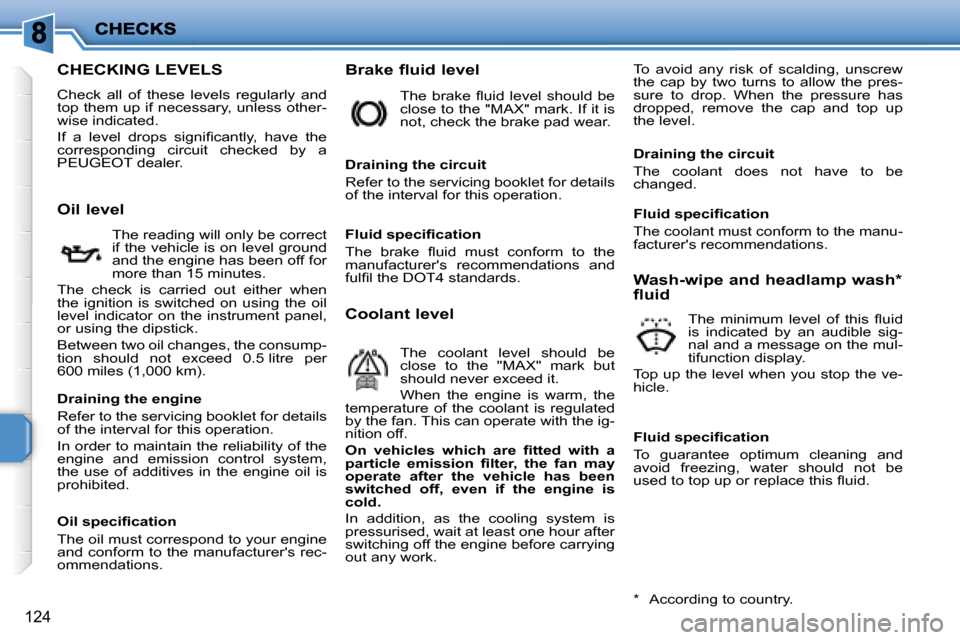
124
CHECKING LEVELS
Check all of these levels regularly and
top them up if necessary, unless other-
wise indicated.
� �I�f� �a� �l�e�v�e�l� �d�r�o�p�s� �s�i�g�n�i�i� �c�a�n�t�l�y�,� �h�a�v�e� �t�h�e�
corresponding circuit checked by a
PEUGEOT dealer. Brake fluid level
To avoid any risk of scalding, unscrew
the cap by two turns to allow the pres-
sure to drop. When the pressure has
dropped, remove the cap and top up
the level.
Oil level The reading will only be correct
if the vehicle is on level ground
and the engine has been off for
more than 15 minutes.
The check is carried out either when
the ignition is switched on using the oil
level indicator on the instrument panel,
or using the dipstick.
Between two oil changes, the consump-
tion should not exceed 0.5 litre per
600 miles (1,000 km). � �T�h�e� �b�r�a�k�e� �l� �u�i�d� �l�e�v�e�l� �s�h�o�u�l�d� �b�e�
close to the "MAX" mark. If it is
not, check the brake pad wear.
Draining the circuit
Refer to the servicing booklet for details
of the interval for this operation.
Coolant level The coolant level should be
close to the "MAX" mark but
should never exceed it.
When the engine is warm, the
temperature of the coolant is regulated
by the fan. This can operate with the ig-
nition off.
�O�n� �v�e�h�i�c�l�e�s� �w�h�i�c�h� �a�r�e� �i� �t�t�e�d� �w�i�t�h� �a�
�p�a�r�t�i�c�l�e� �e�m�i�s�s�i�o�n� �i� �l�t�e�r�,� �t�h�e� �f�a�n� �m�a�y�
operate after the vehicle has been
�s�w�i�t�c�h�e�d� �o�f�f�,� �e�v�e�n� �i�f� �t�h�e� �e�n�g�i�n�e� �i�s�
cold.
In addition, as the cooling system is
pressurised, wait at least one hour after
switching off the engine before carrying
out any work. Wash-wipe and headlamp wash *
fluid
� �T�h�e� �m�i�n�i�m�u�m� �l�e�v�e�l� �o�f� �t�h�i�s� �l� �u�i�d�
is indicated by an audible sig-
nal and a message on the mul-
tifunction display.
Top up the level when you stop the ve-
hicle.
* According to country.
Draining the engine
Refer to the servicing booklet for details
of the interval for this operation.
In order to maintain the reliability of the
engine and emission control system,
the use of additives in the engine oil is
prohibited.
� � �O�i�l� �s�p�e�c�i�i� �c�a�t�i�o�n�
The oil must correspond to your engine
and conform to the manufacturer's rec-
ommendations. � � �F�l�u�i�d� �s�p�e�c�i�i� �c�a�t�i�o�n�
� �T�h�e� �b�r�a�k�e� �l� �u�i�d� �m�u�s�t� �c�o�n�f�o�r�m� �t�o� �t�h�e�
manufacturer's recommendations and
�f�u�l�i� �l� �t�h�e� �D�O�T�4� �s�t�a�n�d�a�r�d�s�.� � �
Draining the circuit
The coolant does not have to be
changed.
� � �F�l�u�i�d� �s�p�e�c�i�i� �c�a�t�i�o�n�
The coolant must conform to the manu-
facturer's recommendations.
� � �F�l�u�i�d� �s�p�e�c�i�i� �c�a�t�i�o�n�
To guarantee optimum cleaning and
avoid freezing, water should not be
�u�s�e�d� �t�o� �t�o�p� �u�p� �o�r� �r�e�p�l�a�c�e� �t�h�i�s� �l� �u�i�d�.� � �
Page 160 of 223

i
i
147
TOWING A TRAILER,
A CARAVAN, ETC.
Your vehicle is primarily designed for
transporting people and luggage, but it
may also be used for towing a trailer. Driving advice
The maximum towing load on a long
slope depends on the gradient and the
outside temperature.
In all cases, pay attention to the coolant
temperature.
Distribution of loads
� Distribute the load in the trailer so
that the heaviest items are as close
as possible to the axle and the nose
weight approaches the maximum
permitted without exceeding it.
Air density decreases with altitude, thus
reducing engine performance. Above
1 000 metres, the maximum towing load
must be reduced by 10 % and so on for
every 1 000 metres of altitude.
Refer to the "Technical Data" section for
details of the weights and towing loads
which apply to your vehicle.
Side wind
� Take into account the increased
sensitivity to side wind. Braking
Towing a trailer increases the braking
distance.
Tyres
� Check the tyre pressures of the tow-
ing vehicle and of the trailer, observ-
ing the recommended pressures.
Lights
� Check the electrical signalling on
the trailer.
The rear parking assistance will be
deactivated automatically if a gen-
uine PEUGEOT towbar is used.
� If the warning light and the
STOP warning light come
on, stop the vehicle and
switch off the engine as
soon as possible.
Towbar suited to the attachment of a
trailer or caravan with additional signal-
ling and lighting.
Cooling
Towing a trailer on a slope increases
the temperature of the coolant.
As the fan is electrically controlled, its
cooling capacity is not dependent on
the engine speed.
� To lower the engine speed, reduce
your speed.
We recommend the use of original
PEUGEOT towbars and their har-
nesses that have been tested and ap-
proved from the design stage of your
�v�e�h�i�c�l�e� �a�n�d� �t�h�a�t� �t�h�e� �i� �t�t�i�n�g� �o�f� �t�h�e� �t�o�w�b�a�r�
is entrusted to a PEUGEOT dealer.
� �I�f� �t�h�e� �t�r�a�i�l�e�r� �i�s� �n�o�t� �i� �t�t�e�d� �b�y� �a�
PEUGEOT dealer, it is imperative
�t�h�a�t� �i�t� �i�s� �i� �t�t�e�d� �u�s�i�n�g� �t�h�e� �e�l�e�c�t�r�i�c�a�l�
pre-equipment installed at the rear of
the vehicle, in accordance with the
manufacturer's instructions. Driving with a trailer subjects the towing
�v�e�h�i�c�l�e� �t�o� �m�o�r�e� �s�i�g�n�i�i� �c�a�n�t� �s�t�r�e�s�s� �a�n�d� �i�t�s�
driver must be particularly careful.